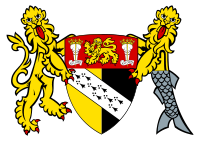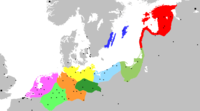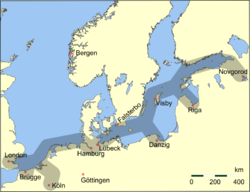Great Yarmouth
| Great Yarmouth | |
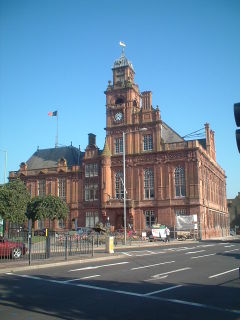 Great Yarmouth Town Hall on Hall Quay |
|
 Great Yarmouth
|
|
| Area | 26.54 km2 (10.25 sq mi) |
|---|---|
| Population | 47,288 (2010 True Knowledge census) |
| - Density | 1,782 /km2 (4,620 /sq mi) |
| OS grid reference | |
| District | Great Yarmouth |
| Shire county | Norfolk |
| Region | East |
| Country | England |
| Sovereign state | United Kingdom |
| Post town | GREAT YARMOUTH |
| Postcode district | NR30 (north), NR31 (south) |
| Dialling code | 01493 |
| Police | Norfolk |
| Fire | Norfolk |
| Ambulance | East of England |
| EU Parliament | East of England |
| UK Parliament | Great Yarmouth |
| List of places: UK • England • Norfolk | |
Great Yarmouth, often known to locals as Yarmouth, is a coastal town in Norfolk, England. It is at the mouth of the River Yare, 20 miles east of Norwich.[1]
It has been a seaside resort since 1760, and is the gateway from the Norfolk Broads to the sea. For hundreds of years it has been a fishing port dependent on the herring fishery, and today it services offshore natural gas rigs. The town has a popular beach and two piers.
Contents |
Geography and demography
The town itself is on a thin spit sandwiched between the North Sea and River Yare. It is home to the historic rows and the main tourist sector on the seafront. The area is linked to Gorleston, Cobholm and Southtown by Haven Bridge and to the A47, A149 and A12 by the Breydon Bridge.
The unparished urban area that makes up the town of Great Yarmouth has an area of 26.54 km2 (10.25 sq mi) and according to the Office for National Statistics in 2002 had a population of 47,288. It is the main town in the larger Borough of Great Yarmouth.[2] The ONS identify a Great Yarmouth Urban Area, which has a population of 66,788, including the sub-areas of Caister-on-Sea (8,756) and Great Yarmouth (58,032). The wider borough of Great Yarmouth has a population of around 92,500.
History
Yarmouth (Gernemwa, Yernemuth) lies near the site of the Roman fort camp of Gariannonum at the mouth of the River Yare. Its situation having attracted fishermen from the Cinque Ports, a permanent settlement was made, and the town numbered 70 burgesses before the Norman Conquest. Henry I placed it under the rule of a reeve.
The charter of King John (1208), which gave his burgesses of Yarmouth general liberties according to the customs of Oxford, a gild merchant and weekly hustings, was amplified by several later charters asserting the rights of the borough against Little Yarmouth and Gorleston. A thirteenth century charter was granted by Henry III (1207–1272) to the town of Great Yarmouth. The town is bound to send to the sheriffs of Norwich every year one hundred herrings, baked in twenty four pasties, which the sheriffs are to deliver to the lord of the manor of East Carlton who is then to convey them to the King.[3]
In 1552 Elizabeth granted a charter of admiralty jurisdiction, confirmed and extended by James I. In 1668 Charles II incorporated Little Yarmouth in the borough by a charter which with one brief exception remained in force until 1703, when Anne replaced the two bailiffs by a mayor. In the early 18th Century Yarmouth, as a thriving herring port was vividly and admiringly described several times in Daniel Defoe's travel journals, in part as follows:
Yarmouth is an antient town, much older than Norwich; and at present, tho' not standing on so much ground, yet better built; much more compleat; for number of inhabitants, not much inferior; and for wealth, trade, and advantage of its situation, infinitely superior to Norwich. It is plac'd on a peninsula between the River Yare and the sea; the two last lying parallel to one another, and the town in the middle: The river lies on the west-side of the town, and being grown very large and deep, by a conflux of all the rivers on this side the county, forms the haven; and the town facing to the west also, and open to the river, makes the finest key in England, if not in Europe, not inferior even to that of Marseilles itself. The ships ride here so close, and as it were, keeping up one another, with their head-fasts on shore, that for half a mile together, they go cross the stream with their bolsprits over the land, their bowes, or heads, touching the very wharf; so that one may walk from ship to ship as on a floating bridge, all along by the shore-side: The key reaching from the drawbridge almost to the south-gate, is so spacious and wide, that in some places 'tis near one hundred yards from the houses to the wharf. In this pleasant and agreeable range of houses are some very magnificent buildings, and among the rest, the custom-house and town-hall, and some merchants houses, which look like little palaces, rather than the dwelling-houses of private men. The greatest defect of this beautiful town, seems to be, that tho' it is very rich and encreasing in wealth and trade, and consequently in people, there is not room to enlarge the town by building; which would be certainly done much more than it is, but that the river on the land-side prescribes them, except at the north end without the gate....
[4].
A grammar school was founded in 1551, when the great hall of the old hospital, founded in the reign of Edward I by Thomas Fastolfe, was appropriated to its use. It was closed from 1757 to 1860, was re-established by the charity trustees, and settled in new buildings in 1872.
From 1808 to 1814 the Admiralty in London could communicate with its ships in the port of Great Yarmouth by a shutter telegraph chain.
The town was the site of a bridge disaster and drowning tragedy on 2 May 1845 when a suspension bridge crowded with children collapsed under the weight killing 79. They had gathered to watch a clown in a barrel being pulled by geese down the river. As he passed under the bridge the weight shifted, causing the chains on the south side to snap, tipping over the bridge deck.[5]
During World War I Great Yarmouth suffered the first aerial bombardment in the UK, by Zeppelin L3 on 19 January 1915. That same year on 15 August, Ernest Martin Jehan became the first and only man to sink a steel submarine with a sail rigged Q-ship, this off the coast of Great Yarmouth. It was also bombarded by the German Navy on 24 April 1916.
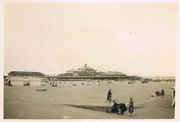
The town suffered Luftwaffe bombing during World War II as Great Yarmouth was the last place to drop bombs before German bombers returned home but much is left of the old town, including the original 2000m protective mediaeval wall, of which two-thirds has survived. Of the 18 towers, 11 are left. On the South Quay, there is a 17th century Merchant's House, as well as Tudor, Georgian and Victorian buildings. Behind South Quay, there is a maze of alleys and lanes known as "The Rows". Originally there were 145. Despite war damage, several have remained.
The northern section of the two-mile A47 Great Yarmouth Western Bypass opened in March 1986, and the southern section in May 1985. It is now the A12.
More recently flooding has been a problem, the town flooding four times in 2006. In September 2006 the town suffered its worst flooding in years. Torrential rain caused drains to block as well as an Anglian Water pumping station to break down and this resulted in flash flooding around the town in which 90 properties were flooded up to 5 ft.[6]
The town was badly affected by the North Sea flood of 1953. On 9 November 2007 the town braced itself for more flooding as a result of a tidal surge and high tides but disaster was avoided and only a small area was under water.[7]
Sights
The Tollhouse, with dungeons, dates from the late 13th century and is said to be the oldest civic building in Britain. It backs on to the central library.
The Market place is one of the largest in England, and has been operating since the 13th century. It is also home to the town's shopping sector and the famous Yarmouth chip stalls. The smaller area south of the market is used as a performance area for community events and for access to the town's shopping centre, Market Gates. In November 2008, a new section of Market Gates opened, including high street retailers such as Debenhams, New Look and Starbucks.
Great Yarmouth railway station, which serves the town, is the terminus of the Wherry Lines from Norwich. Before the Beeching Axe the town had a number of railway stations and a direct link to London down the east coast. The only remaining signs of these stations is the coach park where Beach Station once was and the A12 relief road which follows the route of the railway down into the embankment from Breydon Bridge.
Yarmouth has two piers, Britannia Pier and Wellington Pier. The theatre building on the latter of the two was demolished in 2005 and is currently being rebuilt as a family entertainment centre. Britannia Pier is home to the Britannia Theatre which during the summer months features well known acts including; Jim Davidson, Basil Brush, Cannon and Ball, Chubby Brown, Chuckle Brothers and The Searchers. The theatre is one of a few end of the pier theatres left in England.
The Grade II listed[8] Winter Gardens building sits next to the Wellington Pier. The cast iron framed glass structure was shipped by barge from Torquay in 1903. It is said this was done without the loss of a single pane of glass. Over the years, it has been used as ballroom, roller skating rink and beer garden. In the 1990s it was converted into a nightclub by comedian Jim Davidson. Today, The Winter Gardens are used as a family leisure venue, although its future is under threat owing to the cost of repairing the aging framework. During the winter of 2005 there were worries that building might collapse, and during high winds it was often closed.
Great Yarmouth's seafront, known as "The Golden Mile" attracts hundreds of thousands of visitors each year to its sandy beaches, Pleasure Beach, indoor attractions and amusement arcades. Great Yarmouth's Marine Parade has 12 Amusement Arcades located within 2 square miles, including: Atlantis, The Flamingo, Circus Circus, The Golden Nugget, The Mint, Leisureland, The Majestic, The Silver Slipper, The Showboat, Magic City, Quicksilver and The Gold Rush, opened in 2007.
The South Denes area is home to the Grade I listed Norfolk Naval Pillar, known locally as Nelson's Monument or Nelson's Column. This tribute to Admiral Lord Horatio Nelson was completed in 1819, 24 years before the completion of Nelson's Column in London. The monument, designed by William Wilkins, shows Britannia standing atop a globe holding an olive branch in her right hand and a trident in her left.There is a popular assumption in the town that the statue of Britannia was supposed to face out to sea but now faces inland due to a mistake during construction, although it is thought she is meant to face Nelson's birthplace at Burnham Thorpe. The monument was originally planned to mark Nelson's victory at the Battle of the Nile, but fund-raising was not completed until after his death and it was instead dedicated to England's greatest Naval hero. It is currently surrounded by an industrial estate but plans are in place for the improvement of the area. The Norfolk Nelson Museum on South Quay houses the Ben Burgess collection of Nelson Memorabilia and is the only dedicated Nelson museum in Britain other than one in Monmouth. Its several galleries look at Nelson's life and personality as well as what life was like for the men who sailed under him.

Charles Dickens used Yarmouth as a key location in his novel David Copperfield. The author stayed at the Royal Hotel on the Marine parade while writing David Copperfield. Anna Sewell (1820–1878), the author of Black Beauty, was born in a 17th century house in Church Plain. The house is currently being used as a restaurant after being renovated in 2007.
The Time and Tide Museum on Blackfriars Road which is managed by Norfolk Museums Service was nominated in the UK Museums Awards in 2005. It was built as part of the regeneration of the south of the town in 2003. Its location in an old herring smokery harks back to the town's status as a major fishing port. Sections of the historic town wall are located outside the museum.
The Maritime Heritage East partnership, based at the award winning Time and Tide Museum aims to raise the profile of maritime heritage and museum collections.
Wildlife
The Yarmouth area is home to a number of rare and unusual species. The area between the piers is home to one of the largest roosts of Mediterranean Gulls in the UK. Breydon Water, just behind the town, is a major wader and waterfowl site, with winter roosts of over 100,000 birds. This, and the surrounding Halvergate Marshes are specially protected, and the majority of the area is now owned by conservation organisations, (principally the RSPB).
The North Denes area of the beach is an SSSI due to its dune plants, and is home to numbers of Skylarks and Meadow Pipits. It also hosts one of the largest Little Tern colonies in the Uk each summer, as well as a small colony of Greyling butterflies. Other butterflies found here include Small Copper and Common Blue.
The near-by cemetery is renowned as a temporary roost for spring and autumn migrants, and sometimes sees spectacular 'falls'. Redstart and Pied Flycatcher are often seen here during migration. It has also been the site for the first records of a number of rare insects, blown in from the continent.
Grey Seal and Common Seal are frequently seen off-shore, as are sea-birds such as Gannet, Little Auk, Common Scoter, Razorbill and Guillemot.
Sports and leisure
The local football club is Great Yarmouth Town, also known as the Bloaters, who play in the Eastern Counties League. Currently managed by Paul Tong, their ground is at Wellesley Recreation Ground (named after Sir Arthur Wellesley). They have a strong East Anglian rivalry with Gorleston. The club has enjoyed limited success in the past.
Yarmouth has a horse-racing track which features a chute allowing races of one mile on the straight.
Speedway racing was staged in Great Yarmouth before and after the Second World War. The meetings were staged at the greyhound stadium in Caister Road. The post war team were known as the Yarmouth Bloaters (after the smoked fish). Banger and Stock car racing is also staged at this stadium.
The main Leisure Centre is the Marina Centre. Built in 1981 the centre has a large swimming pool, conference facilities and live entertainment including their famous Summer Pantomimes and Summer Variety Shows produced by local entertainers Hanton & Dean. The centre is run by the Great Yarmouth Sport and leisure Trust. The Trust was set up in April 2006 to run the building as a charitable non profit making organisation.
At the beginning of the 2008 summer season a worlds first Segway Grand Prix was opened at the Pleasure Beach gardens.
Pop Beach
In 2003 and 2004 T4 hosted their music festival at Great Yarmouth. It saw acts like Emma Bunton, McFly and Blue hit the stage. The event brought over 20,000 people but in 2005 the show changed its name to T4 On The Beach and has been in Weston-super-Mare since then. There is currently a campaign to get the show back to Great Yarmouth.
Transport
Rail
Great Yarmouth is connected to Norwich by the Wherry Lines from Great Yarmouth railway station. It is the only remaining station of the three once in the town.
Current station
- Great Yarmouth
Former stations
- Yarmouth Beach
- Yarmouth South Town
Several other stations were located on the outskirts of the town including Belton railway station and Yarmouth Newtown railway station.
Water

Since 2006, the restored pleasure steamer the Southern Belle has provided regular river excursions from the town's Haven Bridge. Built in 1925 for the Earl of Mount Edgcumbe. Today, she is owned by the Great Yarmouth and Gorleston Steam Packet Company Limited.[9]
Road
The A12 terminates in the town as do the A143 and the A47 roads. The relief road was built along the path of the old railway to carry the A12 onwards to Lowestoft and London. Congestion is a major problem in the town and roundabouts, junctions and bridges can become gridlocked at rush hour. Construction work on the Outer Harbour began in June 2007, the harbour which is being built in the South Denes area plans to bring trade to the area and possibly provide a new ferry link with the Netherlands, it is due to be completed by 2009.
First Eastern Counties and Anglian Bus operate the main bus routes with the major stop in the town being Market Gates Bus Station. The Excel coach service operates a direct link to Peterborough, Norwich and Lowestoft. Other local bus services link the suburban areas of Martham, Hemsby, Gorleston, Bradwell and Belton as well as longer distance services to Diss and Beccles. In recent years the bus service in the area has been severely cut back after its privatisation.
Proposed third river crossing

Plans have been put forward for the construction of a third river crossing in Great Yarmouth. This would consist of either a bridge or tunnel, connecting the Southtown area with the South Denes industrial area and the Outer Harbour. Estimated costs for a bridge or tunnel are £80m-£100m and £180m respectively.[10] If the bridge option is chosen, four possible locations have been put forward, all connecting the A143/A12 roundabout to the east side of the river. These include two high bridges, one connecting to Southgate Road and the second to South Beach Paraded. Also two low bridge options have been forward, one connecting to Main Cross Road and another to Beevor Road.[11] Public consultation into the proposal started on 19 June 2009 and will end on 28 August 2009. An announcement on the preferred crossing type and route is expected by the end of 2009 with an estimated four years of the design and planning process to follow.[12] The earliest estimate for the start of construction on any crossing proposal is 2013.[13]
Lifeboat station
There has been a lifeboat in Great Yarmouth since at least 1802. The early boats were privately operated until 1857 when the RNLI took over.[14] The lifeboat station is located on Riverside Road () from where are operated the Trent class lifeboat Samarbeta and the B class (inshore) lifeboat Seahorse IV.[15]
First Responders
There is currently a East of England Ambulance Service First Responder group setting up to cover the Great Yarmouth area. A First Responder scheme is made up of a group of volunteers who within the community in which they live or work, have been trained to attend emergency 999 calls by the NHS Ambulance Service.[16] Responders are members of the community who are trained to use an Automated External Defibrillator, Oxygen and other lifesaving equipment to assist ambulance crews. Community First Responders are not a substitute for the Ambulance Service. But, as they are based within Great Yarmouth, they are able to attend the scene of an emergency call in a very short time; often within the first few minutes and, in the majority of incidents, they will be first on scene. Community First Responders are able to administer vital, life saving first aid treatment before the arrival of an Ambulance crew. Their early intervention further increases the patient's chance of survival or may just provide the simple reassurance that the ambulance crew are on their way. Great Yarmouth First Responders themselves are not paid, being a First Responder is completely voluntary. However the Community First Responder schemes are not funded by the East of England Ambulance Service and rely solely on help from the publics donations.
Notable residents
- Vice-Admiral Horatio Nelson (1758-1805)
- Oscar winning cinematographer Jack Cardiff (1914-2009)
- English physician and writer Dr Thomas Girdlestone (1758-1822)
- Captain George William Manby (1765-1854), inventor of marine lifesaving equipment
- William Hovell (1786–1875), explorer of Australia was born in Great Yarmouth.
- Sir James Paget (1814-99), Victorian Surgeon who had the James Paget Hospital named in his honour.
- Anna Sewell (1820-78), author of Black Beauty
- Leading English Independent Minister William Bridge (c1600-70)
- Alternative rock band Catherine Wheel were from Great Yarmouth
Twinning
Great Yarmouth is twinned with:
 Rambouillet, France
Rambouillet, France
See also
- Great Yarmouth Pleasure Beach
- St Nicholas Church, Great Yarmouth
- Lydia Eva the last surviving steam drifter of the Great Yarmouth herring fishing fleet
References
- ↑ Ordnance Survey (2005). OS Explorer Map OL40 - The Broads. ISBN 0-319-23769-9.
- ↑ Office for National Statistics & Norfolk County Council (2001). Census population and household counts for unparished urban areas and all parishes. Retrieved 2 December 2005.
- ↑ Nuttall, P Austin (1840). A classical and archæological dictionary of the manners, customs, laws, institutions, arts, etc. of the celebrated nations of antiquity, and of the middle ages. London. p. 555. http://www.google.co.uk/books?id=V-gDAAAAQAAJ&pg=PA555&dq=Yarmouth+pasties&as_brr=1.
- ↑ Daniel Defoe, A tour thro' the whole island of Great Britain, divided into circuits or journies (1724), Letter 1, Pt 3. Defoe's several descriptions may be conveniently accessed on the Vision of Britain website, [1]
- ↑ "The Fall of Yarmouth Road". AngliaCampus. http://www.jeron.je/anglia/learn/sec/history/yarmouth/page03.htm. Retrieved 11 October 2009.
- ↑ "England | Norfolk | Homes under water in flash floods". BBC News. 25 September 2006. http://news.bbc.co.uk/1/hi/england/norfolk/5378080.stm. Retrieved 29 January 2010.
- ↑ Turner, Andrew (9 November 2007). "England | Norfolk | Residents ride out storm surge". BBC News. http://news.bbc.co.uk/1/hi/england/norfolk/7086419.stm. Retrieved 29 January 2010.
- ↑ "Detailed Record". Imagesofengland.org.uk. http://www.imagesofengland.org.uk/details/default.aspx?id=468613. Retrieved 29 January 2010.
- ↑ The Southern Belle. Retrieved 29 October 2009.
- ↑ "Keeping Great Yarmouth moving - consultation on future transport plans". Norfolk County Council. 15 June 2009. http://www.norfolk.gov.uk/consumption/idcplg?IdcService=SS_GET_PAGE&ssDocName=NCC068205&ssSourceNodeId=&ssTargetNodeId=3018. Retrieved 6 July 2009.
- ↑ "10 River Crossing". 1st East. http://www.1steast.co.uk/files/files/35-q10-great-yarmouth-river-crossing.pdf. Retrieved 23 July 2009.
- ↑ "Third crossing in Yarmouth". The Beach. http://www.thebeach.co.uk/news/info.php?refnum=2602. Retrieved 6 July 2009.
- ↑ "Great Yarmouth Third River Crossing". 1st East. http://www.1steast.co.uk/development/norfolkcc-progressreport.pdf. Retrieved 6 July 2009.
- ↑ RNLI history of Great Yarmouth & Gorleston lifeboat station.
- ↑ "Great Yarmouth and Gorleston Fleet". Rnli.org.uk. http://www.rnli.org.uk/rnli_near_you/east/stations/GreatYarmouthandGorlestonNorfolk/fleet. Retrieved 29 January 2010.
- ↑ "Great Yarmouth First Responders". gyresponders.org. http://www.gyresponders.org. Retrieved 22 June 2010.
External links
- Official website of Great Yarmouth Borough Council
- "Greater Yarmouth" official tourism website
- Great Yarmouth Tourism, business and attraction listings Great Yarmouth directory listings, find things to do and view all the latest news.
- "Great Yarmouth History" Great Yarmouth History
- "Great Yarmouth" Images Past and Present
- "The Diamond Players Club" - Great Yarmouth
- "Norfolk Broads" Online Directory
- Great Yarmouth & District Archaeological & Historical Society
- Great Yarmouth from the air
- Great Yarmouth Twinning Association
- Great Yarmouth Mercury Newspaper
- Great Yarmouth's Rail Connections A comprehensive site about the present and former railway lines and stations of the area, including the Quay lines.
- A Wartime Childhood in Great Yarmouth A digital story made with pupils from Wroughton First School in the town
- Maritime Heritage East Maritime Museums and Collections Online
- Graeme Cassidy's Great Yarmouth Chronicles on themagiceye at Joyland
- Yarmouth Portal
- Video clip of 'Yarmouth in Days Gone By' - original archive film from Great Yarmouth
- Video clip of 'Yarmouth in the Sixties' - original archive film from Great Yarmouth in the 1960s
- A Vision of Britain Through Time searchable site: enter "Yarmouth".
|
|||||||||||||
|
||||||||||||||||||||||||||||||||||||||||||||||||||||||||||||||||||||||||||||||||||||
|
||||||||||||||||||||||||||
